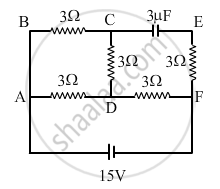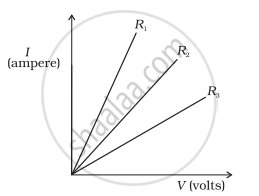Advertisements
Advertisements
प्रश्न
Let the resistance of an electrical device remain constant, while the potential difference across its two ends decreases to one fourth of its initial value. What change will occur in the current through it? State the law which helps us in solving the above stated question.
उत्तर
The change in the current flowing through the electrical component can be determined by Ohm's Law.
According to ohm's law i.e.,
V = IR
V: applied voltage
I: current
R: resistance
⇒ I = `"V"/"R"`
Now potential difference becomes one fourth,
V' = `"V"/4`
So current will be: I' =`(("V"//4))/"R"`
⇒ I' = `"v"/(4"R")`
⇒ I' = `"I"/4`
When the potential difference is one fourth, the current through the component also decreases to one fourth of its initial value.
संबंधित प्रश्न
Will current flow more easily through a thick wire or a thin wire of the same material, when connected to the same source? Why?
Name the physical quantity whose unit is "ohm".
Keeping the p.d. constant, the resistance of a circuit is halved. The current will become:
(a) one-fourth
(b) four time
(c) half
(d) double
In the circuit shown in the figure, find the total resistance of the circuit and the current in the arm AD.

What are non-ohmic conductors? Give one exmaple. Draw a current-voltage graph for a non-ohmic conductor.
Define temperature coefficient of resistance.
Write a short note on superconductors?
A student carries out an experiment and plots the V-I graph of three samples of nichrome wire with resistances R1, R2 and R3 respectively. Which of the following is true?

Ohm's law deals with the relationship between ______
What is meant by resistance of a conductor ? Define its SI unit.
